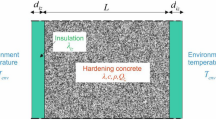Abstract
Upon immersion in water, dam concrete undergoes wet-expansion deformation due to infiltration of moisture. To investigate how first-immersion age affects the wet expansion of dam concrete, wet-expansion tests with five different first-immersion ages (7, 14, 28, 60, and 90 days) are conducted under unified test conditions. Firstly, the statistical model of measured strain of concrete specimen before immersion in water is established, following which the thermal expansion coefficient and autogenous volume strain of the concrete are obtained. Next, based on the measured strain after immersion in water, we separate the wet-expansion strain of concrete specimens with five different first-immersion ages and then calculate the wet-expansion coefficient of each specimen. Finally, the equivalent age theory is introduced to establish an eight-parameter wet-expansion strain model based on equivalent first-immersion age and equivalent immersion time, and an optimization algorithm is used to identify the parameters of the models. The test results show that as the immersion time increases, the wet-expansion strain gradually increases until it becomes stable. The smaller first-immersion age will result in a larger stable wet-expansion strain, but when the first-immersion age is over 28 days, the stable wet-expansion strain becomes independent of the first-immersion age and tends to a similar value at approximately 20 με. The evolution of wet-expansion coefficient is similar to that of wet-expansion strain, and it tends to 3.6 × 10−3 when the first-immersion age is over 28 days. Additionally, the calculated wet-expansion strain based on the eight-parameter model is in good agreement with the measured value, which indicates the feasibility of this model.









Similar content being viewed by others
References
Neville AM, Dilger WH, Brooks JJ (1983) Creep of plain and structural concrete. Construction Press, New York
Neville AM (1995) Properties of the concrete, 4th edn. Longman Scientific & Technical Ltd, London
Bazant ZP, Jirasek M (2018) Creep and hygrothermal effects in concrete structures. Springer, Amsterdam
Rahman M, Chen Y, Ibrahim A, Lindquist W, Tobias D (2020) Study of drying shrinkage mitigating concrete using scaled bridge bays. Int J Civ Eng 18(1A):65–73. https://doi.org/10.1007/s40999-019-00460-z
Carrazedo R, Sanches RAK, de Lacerda LA, Divino PL (2018) Concrete expansion induced by alkali-silica reaction in a small arch dam. Int J Civ Eng 16(3A):289–297. https://doi.org/10.1007/s40999-016-0127-x
Bazant ZP, Wittmann FH (1982) Creep and shrinkage in concrete structures. Wiley, New York
Zhu BF (2012) Thermal stress and temperature control of mass concrete. China Electric Power Press, Beijing
Wei Y, Hansen W (2013) Tensile creep behavior of concrete subject to constant restraint at very early age. J Mater Civ Eng 25:1277–1284. https://doi.org/10.1061/(ASCE)MT.1943-5533.0000671
Fan MZ (2006) Impact of wet-expansion deformation on the stress of the heel of baishuiyu dam. Hydropower Autom Dam Monit 30(2):58–60
Gao Y, Zhang J, Luosun YM (2014) Shrinkage stress in concrete under dry-wet cycles: an example with concrete column. Mech Time Depend Mater 18(1):229–252. https://doi.org/10.1007/s11043-013-9225-1
Zhang J, Gao Y, Han YD, Sun W (2012) Shrinkage and interior humidity of concrete under dry-wet cycles. Dry Technol 30(6):583–596. https://doi.org/10.1080/07373937.2011.653614
Serra C, Batista AL, Monteriro Azevedo N (2016) Dam and wet-screened concrete creep in compression: In situ experimental results and creep strains prediction using model B3 and composite models. Mater Struct 49(11):4831–4851. https://doi.org/10.1617/s11527-016-0828-2
McCarter WJ, Watson DW, Chrisp TM (2001) Surface zone concrete: drying, absorption, and moisture distribution. ASCE J Mater Civ Eng 13(1):49–57. https://doi.org/10.1061/(asce)0899-1561(2001)13:1(49)
Cusson D, Hoogeveen T (2008) Internal curing of high-performance concrete with pre-soaked fine lightweight aggregate for prevention of autogenous shrinkage cracking. Cem Concr Res 38(6):757–765. https://doi.org/10.1016/j.cemconres.2008.02.001
Hanzic L, Kosec L, Anzel I (2010) Capillary absorption in concrete and the Lucas–Washburn equation. Cem Concr Compos 32(1):84–91. https://doi.org/10.1016/j.cemconcomp.2009.10.005
Shen DJ, Wang ML, Chen Y, Wang T, Zhang J (2017) Prediction model for relative humidity of early-age internally cured concrete with pre-wetted light weight aggregates. Constr Build Mater 144(7):717–727. https://doi.org/10.1016/j.conbuildmat.2017.03.088
Wu ZR, Gu CS (2000) The prototype back analysis and application of dam. Jiangsu Science and Technology Press, Nanjing
Wang ZY, Ling Q, Gou XL (2012) Observation and analysis on humidity deformation in hydraulic thin-walled structures. Hydropower Autom Dam Monit 36(1):60–64
Xu WB, Li QB, Hu Y, Li S (2017) Wet swelling effect on crack performance of facing concrete for rockfill dams. Mag Concr Res 69(20):1055–1066. https://doi.org/10.1680/jmacr.16.00367
Huang YY, Yuan B, Xiao L, Liu Y (2018) Studies on the wet expansion deformation of hydraulic concrete with fly ash under non-standard temperatures. Case Stud Constr Mater 8:392–400. https://doi.org/10.1016/j.cscm.2018.03.003
Zhu BF (2011) Compound exponential formula for variation of thermal and mechanical properties with age of concrete. J Hydraul Eng 42(1):1–7
Freiesleben HP, Pedersen J (1977) Maturity computer for controlled curing and hardening of concrete. Nordisk Betong 1:19–34
Kang ST, Kim JS, Lee Y, Park YD, Kim JK (2012) Moisture diffusivity of early age concrete considering temperature and porosity. KSCE J Civ Eng 16(1):179–188. https://doi.org/10.1007/s12205-012-1445-4
Persson B (1997) Moisture in concrete subjected to different kinds of curing. Mater Struct 30(9):533–544. https://doi.org/10.1007/bf02486397
Gu CS, Wu ZR (1996) Research on the expansion stress in wet concrete and application to the allowable stress in arch dams. Dam Eng 7(4):311–316
Zhu BF (1985) Modulus of elasticity, unit creep and coefficient of stress relaxation of concrete. J Hydraul Eng 15(9):54–61
Havin VP, Nikol’skij NK (1995) Complex methods In: Havin V.P., Nikol’skij N.K. (eds) Commutative harmonic analysis III. Encyclopaedia of Mathematical Sciences, vol 72. Springer, Berlin, Heidelberg. https://doi.org/10.1007/978-3-642-57854-0_13
Acknowledgements
This study was supported by the National Natural Science Foundation of China under Grant no. 51779130.
Author information
Authors and Affiliations
Corresponding author
Ethics declarations
Conflict of interest
The authors declare that there are no conflicts of interest related to the publication of this paper.
Rights and permissions
About this article
Cite this article
Huang, Y., Xiao, L., Zhou, Y. et al. How First-Immersion Age Affects Wet Expansion of Dam Concrete: An Experimental Study. Int J Civ Eng 19, 441–451 (2021). https://doi.org/10.1007/s40999-020-00582-9
Received:
Revised:
Accepted:
Published:
Issue Date:
DOI: https://doi.org/10.1007/s40999-020-00582-9




